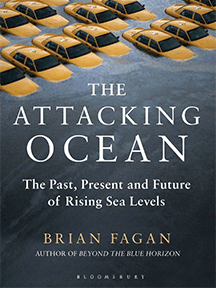Short Listed for the 2014 Phi Beta Kappa Book Award in Science
By David L. Kirchman
The most recent report from the IPCC (Intergovernmental Panel on Climate Change), its fifth, is more assertive than ever about the inevitability of warming global temperatures, melting ice caps, and rising sea levels, all caused by the burning of fossil fuels and other human activity. Climate change is the backdrop to this book, like the incessant da-dum, da-dum of the Jaws movie score. But fortunately, Brain Fagan, a professor in anthropology and archaeology turned popular science writer, tells many fascinating stories that should interest even readers still skeptical of climate change or simply weary of all the bad news.
Some of the stories stretch back to the last period of rapid sea level rise, about 10,000 years ago, when the planet emerged from the most recent ice age (there have been 40 over the last 2.5 million years). At its maximum 20,000 years ago, giant ice sheets covered much of North America and Europe, and sea level was 120 meters (400 feet) below current levels. The low sea exposed a land bridge between Siberia and Alaska, which was used by early humans to cross over into North America and eventually the rest of the Americas. The bottom of the North Sea between England and northern Europe, Doggerland, was also once dry and inhabited for a couple thousand years before it succumbed to rising seas about 7000 years ago. The shore of Lake Euxine, now the Black Sea, was home to early farms and villages, until the Mediterranean Sea rose around 7600 years ago and seawater finally breached the natural beam separating lake and sea. In many chapters, Fagan gives accounts, written in the present tense, of how people may have responded to the disappearance of their world due to the rising seas and changing coastlines. Although his stories are based on archaeological facts, he is unafraid to enliven prehistoric vignettes with odors and sounds added from his imagination.
Other stories chronicle swifter attacks by the oceans. Perched on the Pacific Rim of Fire, Japan has been rocked by tsunamis throughout its history, although the word tsu-nami, meaning “wave in the harbor,” came into use only in the 1600s. The term refers to the destruction of even protected shores by surges spawn by near and distant earthquakes. Written records indicate that at least 195 tsunamis have struck Japan over the last 1300 years. Fagan also relates how India has suffered through monsoon floods and tropical cyclones throughout its long history. The Great Backerganji Cyclone of 1876 killed at least one hundred thousand people near Kolkata, with several hundred thousand more perishing from cholera. Cyclone Bhola hit the entire coast of Bangladesh on November 13, 1970, leveling whole villages and killing at least half a million people. The book has similar, if less deadly stories from Europe, China, the Middle East, and the U.S.
So, people, coastal communities, and states have had to deal with an attaching ocean for millennia, as Fagan vividly portrays. Yet the past is not the same as our present and near-future. Where once there were only scattered tribes or small villages, millions now live in dense megacities protected against the ocean’s assault by dikes or levees or nothing at all. Then there is the ominous da-dum beat of the book: Climate change is another reason why things are different now and why coasts will be challenged by the oceans even more so soon. Climate change is here, and the seas are rising once again.
David L. Kirchman (ΦBK, Lawrence University, 1976) is the Maxwell P. and Mildred H. Harrington Professor Marine Biosciences at the University of Delaware and a resident member of the Alpha of Delaware Chapter of Phi Beta Kappa.




